This study investigated the abundance and detectability of forest owls in south-western Australia. Boobooks occurred 23 times (48% of nights) and the masked owl once in 42 surveys. Tawny frogmouths were detected three times. These results are considered with two other investigations of forest owls in the region.
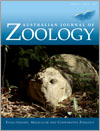
Australian Journal of Zoology
Volume 65 Number 2 2017
ZO17006Spatial ecology of yellow-spotted goannas adjacent to a sea turtle nesting beach
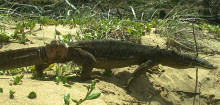
Yellow-spotted goannas (Varanus panoptes) are the main turtle nest predators at the Wreck Rock rookery, adjacent to Deepwater National Park in south-east Queensland. Examination of space-use patterns indicates that it is the larger male yellow-spotted goannas that are the main predators of sea turtle nests at the Wreck Rock beach-nesting aggregation.
Photo by Juan Lei.
ZO16087No evidence of protracted population decline across 17 years in an unmanaged population of the green and golden bell frog in north-eastern New South Wales
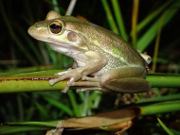
Describing the population trends of threatened species is central to conservation. We conducted mark–recapture modelling for a population of green and golden bell frogs in two periods, 17 years apart. There was no evidence this unmanaged population was in decline. We highlight factors that may cause bias in population modelling.
Photo by Sergio Jacomy.
ZO16079Morphometric analysis of the Australian freshwater crocodile (Crocodylus johnstoni)
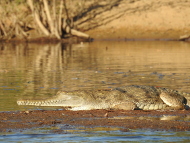
We conducted a morphometric analysis of Crocodylus johnstoni and present formulae which allow the accurate reconstruction of C. johnstoni from measurements of individual body parts. We also compared relative growth in C. johnstoni to that in other species of crocodile and discuss possible ecological correlates of observed differences.
Photo by Yusuke Fukuda.
ZO17005Do female dingo–dog hybrids breed like dingoes or dogs?
The breeding seasonality of female dingo–dog hybrids was investigated. Ovary follicular phase was characterised by growing follicles in late summer and autumn. Characteristics of uterus pregnancy were observed in winter and coincided with a peak of corpus luteum. Overall, the data show that hybrids have a single annual breeding season in winter, exhibiting the same breeding seasonality as dingoes.
ZO16063Ecology of the rare but irruptive Pilliga mouse, Pseudomys pilligaensis. V. Relationships with yellow-footed antechinus, Antechinus flavipes, and house mouse, Mus domesticus

We investigated relationships between Pseudomys pilligaensis and other small mammals in terms of their population fluctuations and habitat selection during its irruption. It is suggested that Mus domesticus was possibly excluded from our sites through competition with P. pilligaensis. This study provides ecological information which can contribute to effective management planning for P. pilligaensis.
Photo by Hideyuki Tokushima.
ZO17025Effect of flow on platypus (Ornithorhynchus anatinus) reproduction and related population processes in the upper Shoalhaven River
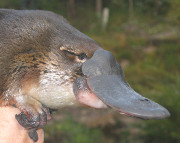
The occurrence of high poststorm discharge in the period when juveniles are confined to nesting burrows was the best predictor of platypus reproductive failure in the unregulated upper Shoalhaven River. In contrast, a significant positive linear relationship was identified between percentage lactation and antecedent March–July flow.
Photo by the Australian Platypus Conservancy.



